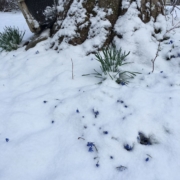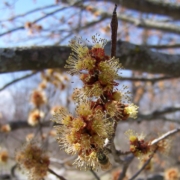Last Snow (We Hope)
I remember hearing a story once about a spring snow like the one we woke up to this morning. A farmer had planted a crop – trees, I think; little seedlings – and then a few days later snow covered the field. The farmer panicked, and ran from seedling to seedling with a broom, brushing the snow off. But there were thousands and he could only get to so many. A few weeks later, all the seedlings he’d rushed to save were dead. And the ones that he hadn’t gotten to had recovered, having weathered the cold temperatures beneath the blanket of snow.
Dispatch from the Sugarwoods, 4/13/20
We gathered our first sap on February 24th this year, and our last on April 2nd. Over the course of that 39-day window we weathered some bordering-on-disastrous weather, and some bordering-on-disastrous mechanical issues – namely a vacuum pump that burned up in the middle of a good run. But we persevered and came out ahead in the end. The farm bush generated 26.8 gallons of sap per tap; the Maple Hill bush generated 29.5 gallons per tap, for an average of 28.2. That average is about 6 gallons per tap better than last year, but the amount of syrup we made was essentially the same because of this year’s low sugar content.
All said, we feel tenuously triumphant. Some of the tenuous feeling can be chalked up to the simple fact that this is agriculture, and there’s only so much you can control. This lack of control does different things to different people. It makes some really religious. It makes some really pessimistic – you know the old stereotype of the farmer who complains when things are bad and complains when things are good. It’s because they don’t trust success; because they’ve been hardened by the lean years enough to find little comfort in the good ones.
Part of the tenuous feeling can also be chalked up to the fact that our operation keeps getting bigger, and the bigger you get, the more you have to lose. We’ve invested tens of thousands of dollars into equipment and technology that enables us to generated close to 30 gallons of sap per tap, numbers that my grandfather would have found astonishing. He would have been tickled with 15 gallons per tap. But the trade-off, of course, is that you become dependent on the big numbers to support your operating costs. Looking back on the season, I remember a moment of panic when I walked into the pump shed and smelled that acrid metal smell coming from the quiet pump. My first thought was to estimate how long I’d be down, and then calculate the economics of being down. I remember, too, looking at my weather app after a week in mid-March when it barely froze at all, and seeing a 10-day forecast that said another week of 60s and no frost. That forecast was wrong; the pattern they were seeing never came to be and we finished strong. But had it been right, we would have, in all likelihood, been sunk at around 50% of a crop. Back when sugaring was part of a diversified farm operation, the sugarmaker shrugged off the bad years and started planting – hope sprang anew. But when maple is your one crop, you’re uncomfortable with lack of diversity if you have any sense.
I share these worries because I’m trying to give you a deeper sense of things beyond “look at our good per-tap average!” And yet in doing so, I’m being a stereotypical farmer and turning something joyful into something ominous. The bottom line is that we had a good year. Maybe I should have just left it at that.
I’m halfway done with the cleanup, and I’m especially conscious of the trees as I pull taps. They’ve given so much. We’re in the midst of a deep, soaking rain as I write this, and I’m thinking of them. Feeling glad for them.


